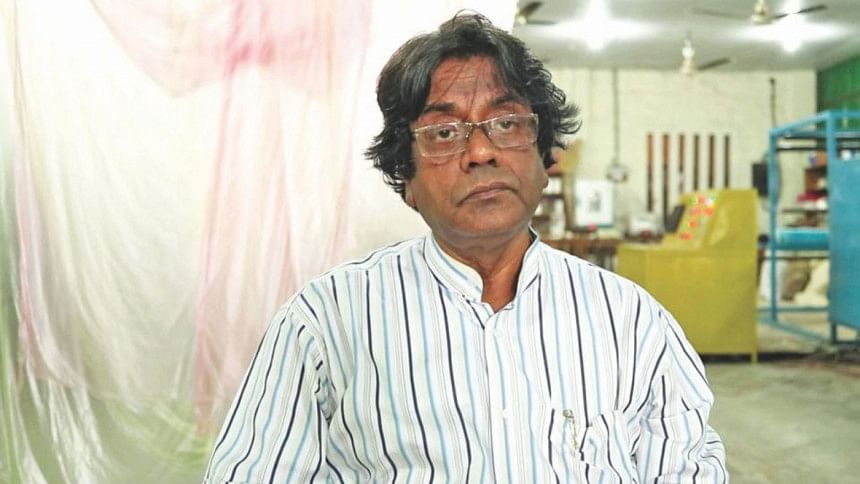We must address the issue of plastic waste to avoid another pandemic

Personal protective equipment (PPE) which comprise of gloves, masks, cover-all, etc. are all essential items in our fight against the coronavirus. However, they may also become contaminated after use and their disposal is a matter of grave concern. Dr Mubarak Ahmad Khan's latest innovation, now at the conceptual stage—a biodegradable, non-toxic material to make PPE (cover-all) which can easily be discarded without causing any harm to the environment—is a game-changer. Not only will his innovation address the urgent need for more eco-friendly PPEs, but it will also help in disposing them in a safe and environmentally friendly manner, thereby reducing the risk of further infections. In this interview, Dr Khan talks to Minam Haque of The Daily Star to discuss his latest innovation.
What inspired you to create biodegradable, non-toxic personal protective equipment (PPE)? Can you discuss the process of how it is made?
The concept of creating a biodegradable cover-all was well in play even before the pandemic struck. In October 2019, a hospital in Japan asked me about the viability of producing biodegradable gowns for their ICU usage, which I made using polymer from jute fibre and they accepted it enthusiastically. They even requested for more gowns and other similar products in bulk, but being a scientist, I was not able to meet their commercial demands.
Plastic waste is usually incinerated (for disposal), but that results in harmful carbon emission which is a threat to climate change. Much of the plastic waste also tends to end up in the water bodies, affecting the aquatic ecosystem as well as clogging the drainage systems. The environmental degradation that results from plastic pollution has always been a matter of great concern globally, and for me as well, even more so during the ongoing pandemic, and hence, I decided to work on techniques that could help address such issues, based on my earlier invention—the Sonali Bag.
The guidelines set by The World Health Organization (WHO) to dispose PPEs is a lengthy and costly process, whereas with my innovation, the cover-all dissolves in soapy water within three minutes and it also disintegrates in plain water within seven days. I also noticed that corpses of Covid-19 positive patients were wrapped in sheets of plastic prior to their burial. It occurred to me that the bodies will decompose within a few months, but the plastic sheets won't. Therefore, my biodegradable material can also be used to make shrouds for dead bodies.
Coming to the non-toxic aspect of my invention, I had already extracted chitosan—derived from the exoskeleton of shellfish which are collected as by-product from shrimps and lobsters that are exported or consumed in restaurants—which has antimicrobial and antiviral properties. I have conducted extensive research on it too. Chitosan can also be used as a harmless preservative in fruits, vegetables, and fish keeping the taste and quality intact. I just combined my two innovations together—using jute cellulose and adding chitosan—and was able to come up with the concept of a biodegradable and non-toxic PPE.
In what ways does your PPE differ from those that are available in the market today? How do their usage and prices vary?
First and foremost, both the cellulose and chitosan used in my PPE are 100 percent natural. It has been reported by many that wearing the PPEs (cover-all) available in the market today is no easy task as they are non-porous, meaning it cannot be worn over lengthy periods. However, my cover-all is much more comfortable to wear. I am yet to standardise the porous factor of it because there aren't any appropriate labs to conduct the necessary testing to make sure that it is safe from the tiniest forms of coronavirus. What sets my cover-all apart from those available in the market is the fact that it has antimicrobial and antiviral properties, making it the safest choice.
As for the pricing factor, an authentic (there are plenty of replicas in the market) disposable WHO approved PPE (cover-all) costs approximately Tk 1,400, whereas the one I produce would cost around Tk 320-340. As I have said earlier, it is also much easier and efficient to dispose the biodegradable PPE and is free from any risk of infection.
Being a fairly new discovery, where does it stand now in terms of mass production? As there is a high demand for PPEs globally, do you see any opportunity to export it to international markets?
I have produced the material in my lab on a small-scale using machineries that I built. My production capacity might be appropriate for providing to the local market. But as for meeting the global demand, that is far beyond my capacity. I can only do so much as a scientist. Mass production is only possible if I get assistance from the state or if other entrepreneurs decide to step in and expand the production process. I can provide all the know-how and the technology, but the rest is up to them.
Moreover, jute is a tremendously promising plant in terms of its harvesting time, the amount of cellulose it can provide, the durability of the materials made from it, etc. Not only will the export of the PPEs be beneficial for the overall economy of our country, but if mass produced, it will elevate the jute cultivation in our nation which will also have a remarkable positive impact on our carbon footprint.
You gained international acclaim after inventing the ground-breaking Sonali Bag. What is its status today?
Well, it's a slow and steady process. Sonali Bag is being produced on a limited scale at the moment. We are also sending samples to various countries around the world, and there seems to be a demand for it. However, like I mentioned, there is a lack of force to make it commercially successful. The fact is, it will require a few hundred crore taka to get the project running on an industrial scale. If the capital can be arranged or is provided for, then it is very possible to mass produce and export it globally.
Your inventions seem to address the concern over plastic pollution in a promising manner. What steps need to be taken in order to fully facilitate the mass production and usage of such products?
I have already manufactured the product, but it now needs to be certified by a recognised body like the WHO in order for everyone to consider my PPE as a standardised product. In order for that to happen, more extensive tests need to be conducted by those who will certify it. And that can be achieved either through government intervention or if I receive enough funds to carry on with the necessary procedures. Once that is done, many might be interested to take on the production on a commercial level.
Despite having my product in hand, I did not make any announcement publicly until recently, following the acceptance of my concept by the Massachusetts Institute of Technology (MIT) in the US. With their approval, I can conduct more research at icddr,b to start the clinical trial of the product and so on. We are also going to test the new concept at Shishu Hospital soon. We already lag in our fight against plastic pollution. If we do not immediately address the issue of plastic waste from PPEs, we may soon face an epidemic as a consequence.

 For all latest news, follow The Daily Star's Google News channel.
For all latest news, follow The Daily Star's Google News channel. 



Comments